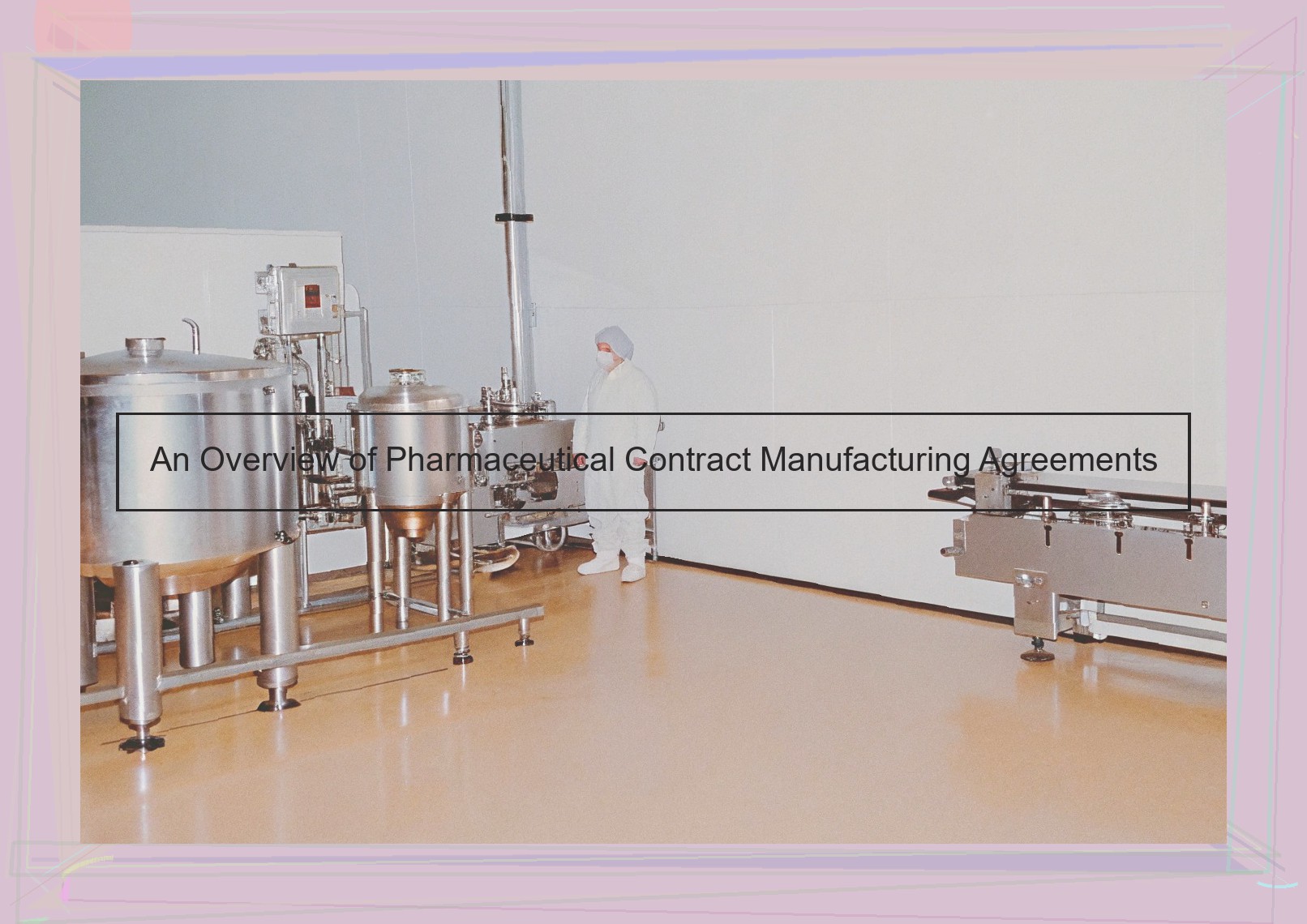A Primer on Pharmaceutical Contract Manufacturing
Manufacturing is a critical part of the pharmaceutical industry. For the pharmaceutical company, such manufacturing could include toll manufacturing, contract manufacturing and private label manufacturing. These processes require skilled labor and expensive equipment and facilities. Pharmaceutical companies may choose to design and operate their own manufacturing facility, or they may outsource manufacturing to a third party. Toll manufacturing is characterized as the physical and technical production of pharmaceutical products by a contract manufacturer at the contract manufacturer’s own facility, according to the specifications in an agreement . In this article, we will discuss the different types of pharmaceutical contract manufacturing agreements and some key considerations.
Pharmaceutical manufacturers enter into contract manufacturing agreements for several reasons. Primary reasons for companies to contract include minimizing costs and achieving savings through purchasing economies and reduction in overhead costs. Another reason for using contract manufacturers is to gain faster access to specialized expertise and state-of-the-art technology.
Pharmaceutical companies believe they can gain various advantages by outsourcing part of the manufacturing process, including increased flexibility in meeting both urgent and long-term demand, access to high-tech equipment and reduced capital and infrastructure costs.
Components of a Manufacturing Agreement
Many of the issues we have discussed regarding research and development agreements also apply to manufacturing agreements, which are entered into when a third party will produce Pharmaceuticals on behalf of a product sponsor. Agreements may provide for a single supply commitment (usually for a bulk Active Pharmaceutical Ingredient ("API")) or, they may be long-term agreements covering all phases of development and commercialization. Some of the key components of these agreements are: manufacture of the pharmaceutical substance, therapeutic product or medical device; procurement; quality assurance and quality control; warranty; safety assessments; confidentiality; intellectual property ownership; and dispute resolution. These agreements will often detail the scope of work to be performed, the responsibilities of the parties, permissions, intellectual property, liability, indemnification etc.
Arguably, one of the most important considerations for any pharmaceutical contract manufacturing agreement is a description of the obligations that go along with the underlying intellectual property. For example, if the transfer of intellectual property only occurs once a manufacturing scale-up is complete, then the contract should detail the ramifications thereof. Additionally, prior to or during the scale-up of manufacturing, there may be changes to the original manufacturing process that must be memorialized. Depending on the size and complexity of the project and it’s corresponding activities, it may be prudent to include a standalone research and development agreement that deals with those specific matters rather than an all-encompassing agreement.
Important Legal Issues to Consider in Drafting a Manufacturing Agreement
A critical element of any Pharmaceutical Contract Manufacturing Agreement is the need to understand and comply with FDA Title 21 Code of Federal Regulation 211. The FDA expects the parties to negotiate and agree on the responsibilities and limits of the Contract Manufacturer ("CM") and the Purchaser. Negotiation and drafting of clauses associated therewith becomes a key document.
In negotiating the agreement, the Purchaser seeks to minimize its liabilities, including indemnification, and the CM wants to maximize its liabilities, including indemnification. Therefore, in preparing to negotiate the clauses, both parties should identify their priorities and make those priorities clear in the negotiation.
The indemnification clause is the most likely to be rejected by the CM, being concerned that it will be held liable for everything that can happen in connection with the manufacturing process and the Purchaser will be held harmless. The situation can be improved by attempting to allocate liability in a more equitable fashion. One way to do this is to limit liability to the cost of the work performed at the time that the claim arises and possibly to put a cap on damages. Additionally, the CM may seek to include exclusions for intentional acts, gross negligence (or similar terms) or those arising from the negligence of the Purchaser. The Purchaser may seek similar provisions to obtain indemnification for errors in specifications or other documents provided to the CM.
Risks for product returns, recalls and destruction, adverse effects, material defects or product failures should be borne by both parties and negotiated (and allocated) among them. It is best to deal with these risks specifically now, than try to negotiate or allocate them in the future. Each side must ensure that it has appropriate insurance to cover possible liabilities as negotiated and, in some cases, risk-based insurance may be used as a means of managing risk.
The Use of PDFs in Managing Contracts
Pharmaceutical contract manufacturing agreements require comprehensive terms and conditions. It’s not uncommon for these documents to be 20 or more pages. It’s also not uncommon for all parties to enter, vacate, and enter the contract several times, making it important that all parties be able to read the same contract at the same time. Tracking this contract over time can also be a burden, since it’s likely that any party will need to look up the agreement at some point for a second or third time.
The Microsoft Word file format, while ubiquitous, does not support consistent formatting across computers. You may email a Word document to someone else, but you can’t guarantee that the person receiving the document will see the exact same file you sent, especially if you are using unusual fonts. The only immediate fix to ensure that this person sees the same contract you intend is to re-scan the document as a PDF, save it as a new Word file, and send this new document along. While this is not hard to do, it’s also time consuming, and if your company has a deadline to meet, this can be counterproductive. Fortunately, there exists a universal file format for documents that allows for easy distribution while still ensuring that a contract is all but unalterable. This document/file format is the portable document format, or PDF.
PDF files are a specifically formatted file type that allows for complex documents to be shared with parties regardless of their operating system or device. Unlike other document formats that have some sort of dependency on the programs that create them, PDFs can be read on almost any device in almost any operating system with the same look and feel. This is due to the fact that PDFs are not created by printers, but rather "printed" to PDF files by programs. This processing within the file itself means that when a computer receives a PDF, it does not need to possess the same program as the computer that created the PDF. PDFs also have active text and image layers, meaning the actual document is not "flattened" into an image.
This accurate document generation is the key reason why documents viewed at a distance will seem to "jump" as hierarchical elements from the document animates into space while you view a document, allowing you to interact with the document. This interaction, however, is not how we should focus our attention on PDF files. Instead, we should concentrate on why a pharmaceutical contract manufacturing agreement document is better as a PDF than as a Word document that can be edited to suit the needs of those that need to see a particular contract.
One reason is that a pharmaceutical contract manufacturing agreement can often be complex, and the act of editing a complex document over time can naturally lead to differing versions of a contract, if those creating PDF copies are not careful to save their copy under a new name and not overwrite old PDF versions. With a Word file, however, overwriting may remove valuable information that describes the changes a particular party has made to a document. It can also cause confusion if those responsible for reading and managing a pharmaceutical contract manufacturing agreement are not following a strict naming standard for these documents.
For this reason, it can be highly advantageous for those creating contracts to simply have the document signed, and then "printed" to PDF with nothing else done to the contract. This creates a "master copy" of the contract that nobody will edit, regardless of their intentions. Each person that needs to see the revisions, updates, or other changes can copy the PDF file to their own computers, and the signed original contract remains untouched.
It may seem like a minor issue, however there is significant value to having an accurate record of the contracts your business has interacted with. A contract manufacturing agreement for a pharmaceutical manufacturing firm can be written a dozen times, and it’s impossible to guarantee that the person receiving the document will open all twelve copies, especially since those at the contract manufacturer need to understand the contract, and will need to ask those outside of machinery production and processing to explain various terms and conditions as they work with the contract manufacturer.
Key Tips to Keep in Mind When Negotiating a Manufacturing Agreement
In the world of pharmaceuticals, selecting the right contract manufacturer (CM) and ensuring a smooth working relationship is critical for success. While price is often a key motivating factor, there are a number of elements that equal or outweigh a lower price during negotiations. CMs function as an extension of the drug company, and the importance of balancing quality, cost, and time cannot be overstated.
Consider the following best practices for successful pharmaceutical contract manufacturing negotiations:
CM Evaluation and Selection
Due diligence in selection is critical. If a company can begin with a CM that is well-aligned, much back and forth may be avoided or minimized. Be prepared to discuss the technology transfer process in detail, including up front costs. With careful planning and negotiation, timing becomes aligned with investment.
Timelines
Reserve a top-level discussion with senior management during the first planning meeting. Questions should be asked about the internal process involved in drug development and the decision-making structure for the outsourcing of CM. Ask for a detailed timeline of steps involved in the CM process and how long each step takes , particularly the final step when the FDA approval is granted. Too often, unexpected delays and avoidable costs can be attributed to poor planning and scheduling.
Pricing
Predicting the future pricing of raw materials can be very difficult. However, requesting a yearly price range is possible, and projecting costs for the duration of a multi-year product launch is highly recommended. Taking time to recommend sources of supply in advance can also be useful.
Intellectual Property
When negotiating key strategic components of the agreement, are all proper intellectual properties being protected? Be certain to explain to the CM that the product is not just an extra line that will fill their production requirements. The CM is an extension of the company, and co-development opportunities are very possible and often encouraged. Will the products produced by the CM be used for company use only? Or can they be sold to a third party through the CM’s sales organization? Strong CM companies have a vested interest in the success of products for which they have invested time and money. A drug company can often capitalize on the CM to gain international distribution.
Common Obstacles and How to Overcome Them
Manufacturers in the pharmaceutical industry are also not immune to the common supply chain disruptions that have become increasingly common in all manufacturing sectors in the past several years. A 2013 survey predicted that nearly 20 percent of pharmaceutical companies would have suffered from a disruption to their supply chain by 2015 resulting in some type of production stoppage, loss in productivity, or safety incident. A quick survey of the Deloitte 2019 Global CPO Survey shows that supply chain risk is rapidly moving from number two among the biggest trends that will impact the pharmaceutical industry to number one. The survey identifies the top four risks as: cyberattacks, social expectations of sustainability, climate change, and supply chain disruption. Two of the four can be addressed as discussed previously by investing in both artificial intelligence and blockchain technology into the supply chain. Managing supply chain disruptions and cyberattacks is more complicated and requires a little more investment in both material and human capital. Manufacturing companies must lay the groundwork for managing disruptions by establishing a clear contingency plan that can be enacted in times of crisis. These plans should identify the person responsible for implementing the plan as soon as possible after discovering a threat so that the plan can be implemented quickly and effectively. Manufacturers can use a tiered system to designate three levels of responses to supply chain disruption that can employ a wide range of responses including everything from changing the manufacturing process to securing alternate suppliers. Tier One is relatively straightforward including owning an adequate number of heavy duty generators to keep the lights on in the event of a power outage. Tier Two includes a range of responses that can be used to address supply chain disruptions by securing the right quantity of the appropriate components in the event of disruption. Finally, Tier Three contingencies should be reserved for a major disruption that necessitates a change in the very foundation of production processes and procedures.
A Summary
By understanding the key terms and conditions of a pharmaceutical contract manufacturing agreement and how those terms will affect your company’s manufacturing relationships, you can minimize your risk of exposure . Well-written agreements that incorporate appropriate allocation of risk can foster successful outsourced biomaterials and drug manufacturing relationships.



